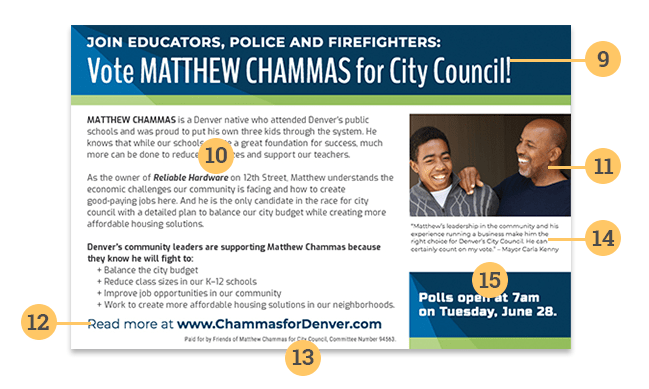9. CALL BACK CTA: This is the most important part of your message! Make sure it is featured on both sides of your mail piece.
10. BIO TEXT: One of the benefits of direct mail is that it allows more space to tell your story and communicate your values than a digital ad. Talk about your roots in the community you want to represent, your qualifying experience, and the things you want to accomplish for your voters. This is also a great place to note endorsements from unions, other representatives, and community groups.
Pro-Tip: The amount of space provided by a piece of direct mail can often tempt you to fill it with as much information as possible. Remember that the space you don’t use is just as important. Keeping paragraphs short and breaking up information with numbered lists or bullet points will make sure your words “pop” and stay in the reader’s memory. Giant blocks of unbroken text are tiring to the eye, and often go unread. Text should be easily scannable, not crowded or busy. Give your words room to breathe!
11. PERSONALITY PHOTO: This is any photo, besides your headshot, that communicates your approachability and sense of community, and ideally features you interacting with others. It might be a photo with your family or an action shot of you serving your community. It reminds voters that you are a real person with ties to the people and places that you care about.
12. CAMPAIGN URL: Make sure that your website is all set up and populated with more information about you, your background, your aspirations for office and your political and personal values. This should be one of the first things you do when you file for office!
13. FINANCIAL DISCLAIMER: This is absolutely crucial and must be reported to the very letter of the law. You do not want to find yourself on the wrong side of election finance guidelines, so make sure you check the exact specifications that your election requires. This will include the name of the entity paying for your mail piece, the registered address of that entity, and even the size of font that this information must appear in.
14. PHOTO SUBTITLE: Provide context for your Personality Photo! Details like your family’s names, a group that you’re volunteering with, or a location that is specific to your district all add a personal touch that can make you more accessible to your voters.
15. POLLING DATE/PLACE CALL BACK: All of the information and messaging you’ve shared on your mail piece won’t help if voters don’t know where and when to vote for you! The most essential goal of any campaign communication is to get your voters to the polls.
These are just some of the basic components of how to lay out a compelling and memorable piece of direct mail for a political campaign. All of SpeakEasy’s Direct Mail Templates have been tested and designed by artists and campaign professionals with years of political experience. We know what works and how to make your mail stand out from the stack!
If you have any questions, or want to learn more about how we can help you use direct mail to achieve your campaign goals, our team is standing by to help! You can schedule a call with one of our campaign professionals, or reach out to us at hello@speakeasypolitical.com!






